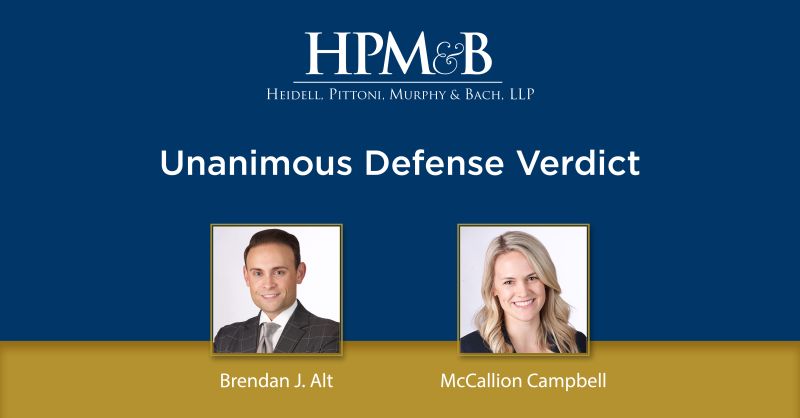Unanimous Defense Verdict
HPM&B recently obtained a unanimous defense verdict on behalf of an attending cardiologist and a major Hospital network in Supreme Court, Westchester County. The case involved an alleged negligently performed transesophageal echocardiogram (TEE) resulting in an esophageal perforation, sepsis, extended hospitalization, the need for a feeding tube, malnutrition, and prolonged skilled nursing services. Plaintiff’s pre-trial demand was $1.25 million.
During the trial, the defense established that esophageal damage is a known risk of a TEE and that appropriate informed consent was obtained. The defendant cardiologist asked the patient certain pre-procedure screening questions to elicit a history about potential gastrointestinal tract pathology. The patient declined any history of difficulty swallowing, prior upper endoscopy, or knowledge of any esophageal stricture, mass, or tumors. At the beginning of the procedure, the defendant encountered difficulty while engaging the TEE probe into the esophagus. Using standard techniques, he was able to maneuver around the resistance and enter the esophagus where he obtained good quality imaging of the heart. He then encountered a second episode of resistance and immediately aborted the procedure. Following the TEE, the patient complained of severe neck pain and a CT scan result was consistent with a perforation near the entrance of the esophagus. The patient became septic, required ICU admission, pressors, and IV antibiotics. Subsequently, the gastroenterology team performed an esophagogastroduodenoscopy (EGD) and diagnosed a Zenker’s diverticulum in the cervical esophagus with a perforation at the apex of the outpouching.
The defense was able to establish that resistance while engaging the probe into the esophagus is common due to varying anatomy or esophageal spasm, and that the defendant cardiologist employed appropriate technique in response to the resistance. He properly pulled back on the probe, changed the angle of the probe, and adjusted the patient’s neck. After that, he was able to successfully engage the probe into the esophagus. In retrospect, the perforation likely occurred during the initial attempt to engage the probe into the esophagus when it entered the unknown Zenker’s diverticulum. The defendant testified that the initial resistance he felt was no different than many other cases. Moreover, the Zenker’s diverticulum significantly increased the risk of a perforation because the outer lining of the diverticulum is inherently weak. The diverticulum sac develops over time as the weak esophageal tissue stretches outward forming a pouch. As such, the defense established that a perforation can occur in a diverticulum even with the normal amount of force needed to engage the TEE probe into the esophagus.
The jury returned a unanimous defense verdict in approximately 20 minutes.
